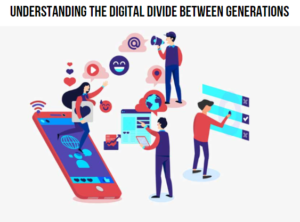
The concept of the digital divide refers to the disparities in access to technology and digital literacy between different demographic groups, particularly between older and younger generations. This divide is influenced by various factors including socioeconomic status, education level, and geographic location.
- Access to Technology
Access to technology is a primary factor contributing to the digital divide. Younger generations, often referred to as “digital natives,” have grown up with technology integrated into their daily lives. They typically have greater access to devices such as smartphones, tablets, and computers. According to a report from the Pew Research Center in 2021, approximately 95% of teenagers in the United States own a smartphone, while only about 60% of adults aged 65 and older reported owning one.
In contrast, older adults may face barriers such as financial constraints or lack of familiarity with new technologies that limit their access. Many older individuals may not feel comfortable using advanced technology or may not see its relevance in their lives. This can lead to lower rates of ownership for devices that facilitate internet access.
- Digital Literacy Skills
Digital literacy encompasses not just the ability to use technology but also understanding how to navigate online environments safely and effectively. Younger generations generally possess higher levels of digital literacy due to their extensive exposure from an early age. They are more adept at using social media platforms, searching for information online, and utilizing various applications.
Conversely, many older adults may struggle with these skills due to limited experience or training opportunities. A study published by the National Institute on Aging indicated that only about 30% of seniors felt confident using the internet for tasks like online banking or shopping compared to over 80% of younger adults.
- Implications of the Digital Divide
The implications of this divide are significant. Limited access and skills can affect older adults’ ability to engage in essential services that increasingly rely on technology—such as telehealth appointments, online banking, and accessing government services. The COVID-19 pandemic highlighted these issues when many services transitioned online; those without adequate digital skills faced challenges in accessing necessary resources.
Furthermore, social isolation has been exacerbated by this divide; older adults who lack technological skills may find it difficult to connect with family and friends through digital means, leading to feelings of loneliness.
- Bridging the Gap
Efforts are being made across various sectors—governmental organizations, non-profits, educational institutions—to bridge this gap through training programs aimed at improving digital literacy among older populations. Initiatives include community workshops that teach basic computer skills or provide hands-on experience with devices.
Moreover, policies aimed at increasing broadband access in underserved areas can help mitigate some aspects of the digital divide by ensuring that all individuals have equal opportunities for connectivity.
In conclusion, while younger generations tend to have better access and higher levels of digital literacy compared to older generations, ongoing efforts are crucial in addressing these disparities for a more inclusive society where everyone can benefit from technological advancements.

Recent Comments